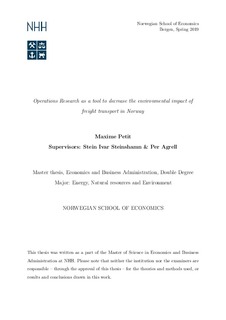Operations research as a tool to decrease the environmental impact of freight transport in Norway
Master thesis
Permanent lenke
http://hdl.handle.net/11250/2609863Utgivelsesdato
2019Metadata
Vis full innførselSamlinger
- Master Thesis [4372]
Sammendrag
Over the past decades, the volume of freight transported over the world has increased a lot.
It has allowed the freight transport sector to develop itself. Transporting commodities has
become very efficient thanks to the use of multimodal containers. And these volumes are
expected to continue to grow in the future. Despite it, transporting such high volumes has
external costs. The most important one concerns the environment. The transport sector
emits huge amounts of CO2. This Greenhouse Gas is the biggest cause of the greenhouse
gas effect which is itself the cause of global warming. The concerns around global warming
are rising faster than ever and the transport industry must also deal with it. There
will be a need for new and less consuming technologies, but these improvements cannot
help a sufficient decrease of CO2 emissions. That is why there is a need for structural
changes of the transport sector. And more specifically, the transport industry needs the
less consuming transport modes to be more competitive.
The aim of this thesis is to analyze and demonstrate how Operations Research can be a
useful tool to help decreasing the CO2 emissions of the transport sector. In fact, planning
models are very effective to analyze and assess policies or other improvements that have an
impact on the decisions made in the transport sector. In order to decrease the emissions,
the external environmental cost has to receive more attention in the decision process
of transport companies. The impact of strategic decisions on the distribution over the
different modes can therefore be assessed with the help of tactical models.
In this thesis, a tactical planning model is built and adapted to national freight transport
planning in Norway. This model is then used to assess multiple strategic policies. The
conclusions of the different policies tested are drawn at the end of the document. The
model can easily be adapted to multiple different situations and the mechanisms used in
this paper are adaptable beyond the Norwegian example.
